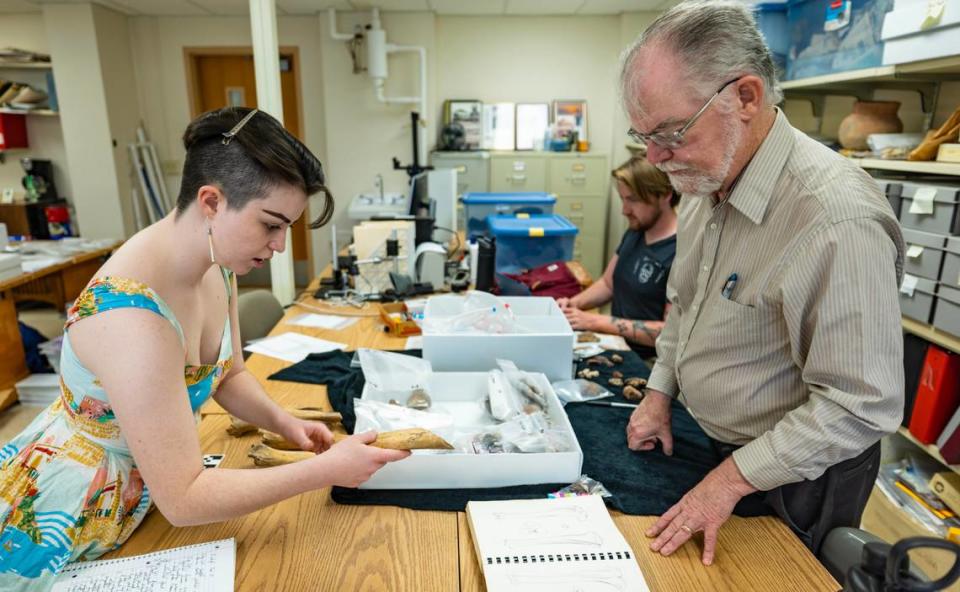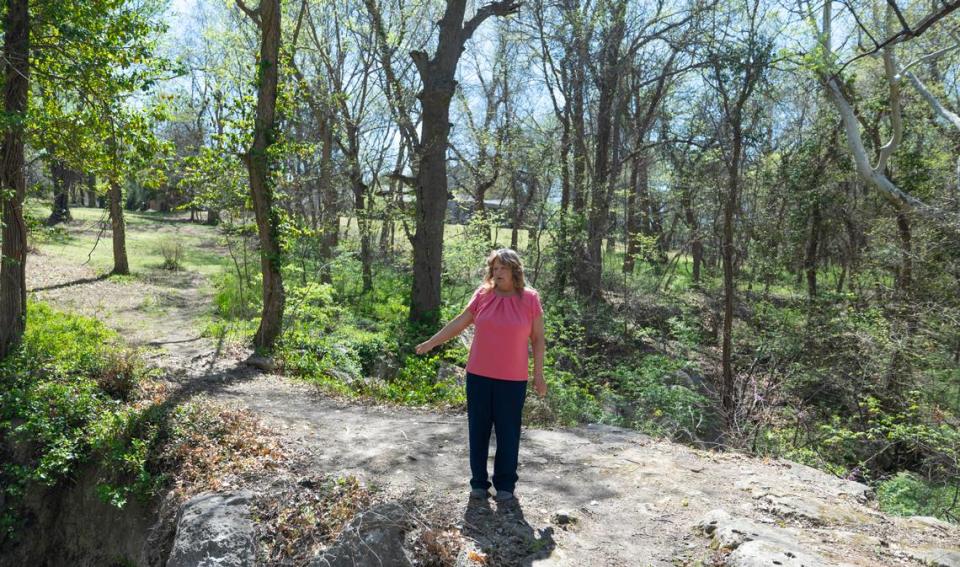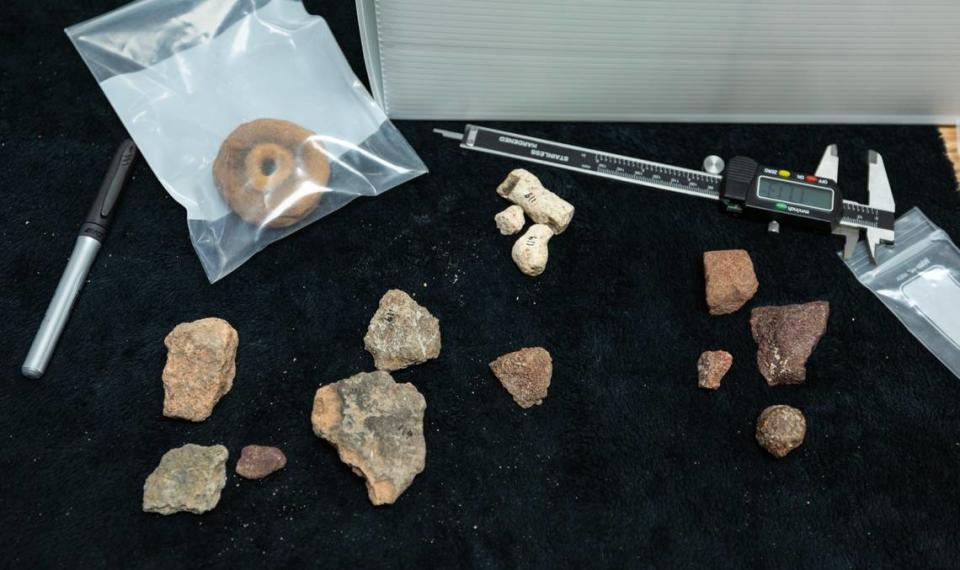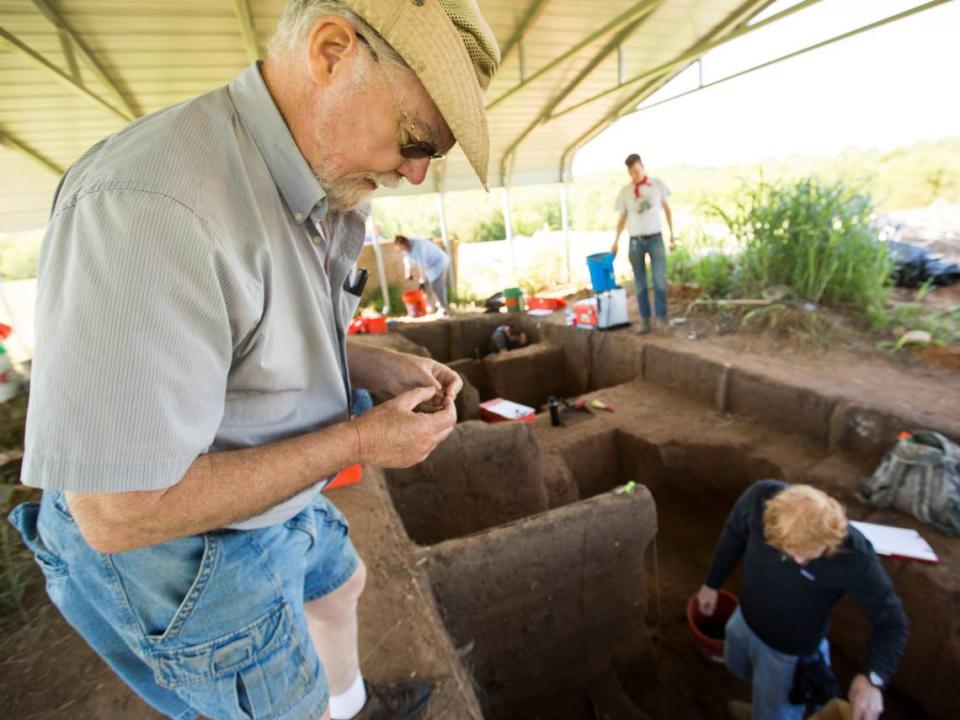WSU says professor is revolutionizing Native American history on the Plains, but is he?
The Native Americans of the pre-Columbian Great Plains are not the stars of history books.
They’ve been described as hunters and gatherers on sparsely populated land far from European colonies, but what if chronicles have gotten it wrong?
Imagine instead a thriving population — perhaps more than 200,000 strong — not only hunting but creating a trading network emanating from modern day Kansas and stretching from Florida to California and down into Mexico.
That’s what Wichita State University archaeologist Don Blakeslee asserts.
According to a WSU news release, the professor of anthropology is “rewriting the history of where the beating heart of” the country was in prehistoric times.
When Blakeslee announced his findings last month and said it’s time for history books to be updated, he generated some buzz along with some skepticism.
Blakeslee says that Quivira — what he called a nation of loosely connected Native settlements in most of eastern Kansas, northeast Oklahoma and a piece of western Missouri starting in the 1300s and getting fully formed by 1450 — was much larger and more populated than previously thought.
“It’s going to revolutionize our view of the Great Plains societies, and it already has for me and my students,” Blakeslee said in the release. “In its day, Quivira was probably the most important native political unit in what’s now the United States.”
Not everyone agrees. Among the people questioning his findings are other archaeologists and present-day members of the Wichita and Affiliated Tribes, who are based in Oklahoma.
“I’m not at all surprised that people are skeptical, because this is big news,” Blakeslee said. “I expect it. I question other people’s work all the time.”
In 2017, Blakeslee was heralded for discovering what he called the 20,000-person lost Wichita settlement of Etzanoa in Arkansas City, though there are arguments about how much of the claim belongs to him.
For proof of his latest findings, Blakeslee pointed to archaeological, linguistic and documentary evidence.
“It could all be true; we just want him to release the evidence,” said Terri Parton, president of the Wichita and Affiliated Tribes in Anadarko, Okla. “That would help probably ease everybody’s mind about what he’s saying.”
‘A huge debate’
Parton e-mailed The Eagle a list of more than a dozen concerns the tribes have regarding Blakeslee’s findings.
For instance, she wants to know more about interpreters, priests and ambassadors that Blakeslee said were at Quivira.
“These are not usually words used in our history,” Parton said in the e-mail.
She said she also wants documentation for Blakeslee’s claims of when the nation formed, what language its people spoke and what tools they used. She also questioned what Blakeslee said are Quivira’s boundaries.
“There’s lots of claims there,” Parton said. “We want to see the evidence. That’s all I can say.”
Blakeslee said it’s coming.
“You can’t put the proof into a press release,” he said. “There’s far, far too many details.”
Blakeslee said he’s on chapter 11 of a 19-chapter book he’s writing on his findings, which he hopes to publish in about a year.
Susan Vehik, professor emerita at the Department of Anthropology at the University of Oklahoma, said archaeology builds knowledge over long periods of time.
Blakeslee “likes to present things as concrete when there’s actually a huge debate,” she said.
“It’s fraught because of the nature of archaeological research. You never know if you’ve covered the entire site. It’s incredibly expensive to do archaeology.”
She said people will question if an excavation was done correctly. Was it interpreted correctly?
“There’s just so many variables, it will probably always be a topic of debate. We’ll just sort of narrow the debate, and that’s what’s happened over . . . more than 100 years,” Vehik said of Etzanoa, Quivira and archaeology generally.
“It’s not rewriting history. It’s building on the history of archaeological research in that area.”
Blakeslee agreed — to a point.
“Yes, archaeology builds knowledge slowly, but every once in a while, you learn something that’s very different from what everybody thought.”

Robert Hoard, retired state archaeologist, said Blakeslee’s enthusiasm is understandable, and he said it’s his right to make assertions.
“But rewriting history is a little grandiose,” Hoard said.
“There were other remarkable prehistoric trade and cultural centers in North America such as the Southwestern Pueblos, Cahokia, and the Hopewell cultural network, and their descendants are among the North American Tribal Nations still with us today.”
Remarkable, sure, Blakeslee said, but not as big as what he said he’s found.
“Yeah, we’re going to argue about it, but I’m confident the documentary evidence is there.”
Mapping the past
Vehik knows the difficulty of getting new findings accepted.
Her reorientation of an ancient map was one of the keys to revealing the Etzanoa site.
“That’s true, absolutely,” Blakeslee said. “She deserves credit for figuring out that map.”
Much of what is known about Etzanoa is from a couple of documented Spanish expeditions, including conquistador Juan de Onate’s 1601 exploration of what today is Kansas.
Though the documents from that expedition were transcribed years ago, the University of California at Berkeley published an updated translation online in 2013.
There was newspaper documentation dating to 1896 when an Arkansas City resident digging a cellar fell into a hole and found native stone tools.
During digging for a golf course on the east side of the city, a trove of artifacts began turning up starting in 1915.
“This in town became what’s known as the Indian Village because of the newspaper press,” said Sandy Randel, director of the Etzanoa Conservancy in Arkansas City.
The first archaeological research around Arkansas City was done by North Newton native Waldo Wedel while he was working for the Smithsonian in the 1940s.
“He was convinced Etzanoa was here,” Randel said.
“Wedel was so cautious about any statement he made that he really didn’t promote it that much in his publications,” Vehik said.
A native Onate had captured — a man dubbed Miguel — drew the map of Etzanoa that Vehik eventually reoriented.
“We affectionately call it the Miguel map,” Randel said.
The reason no one could quite place where the map reflected is because it was drawn with east at the top instead of the more customary north.
“I just started turning the map around, and finally I got it into an orientation that reflected the southern Plains that I was familiar with, and I thought, holy s---,” Vehik said. “Wedel laid the groundwork, then I came through in ’83 and just basically said, ‘Hey, this map is wrong. Reorient it, and Etzanoa is probably where Ark City is.”
Blakeslee noted that Vehik wrote an article that also said it could have been in Oklahoma near Beaver Creek.
“Yes,” she said, “I tend to hedge my bets, and Don doesn’t.”
Regardless, a well-known ethnohistorian was, to put it politely, ticked off with her findings.
“The people who had previously talked about the map were big-time historians, and anytime you mess with somebody big’s ideas, everybody’s like, ‘Hmmm, don’t know about that,’ ” Vehik said.
“Yeah,” Blakeslee said, “I sympathize with her on that one.”
‘Overly ambitious’
In the early 1990s, the Kansas Historical Society did extensive excavation with the rerouting of U.S. 77 and the building of levees along the Arkansas River.
Hoard, the former state archaeologist, said they were massive, meticulous excavations.
“It just turned out to be overly ambitious.”
It was so overwhelming, no one ever wrote a report to analyze the findings, and Hoard wanted to rectify that after he joined the Historical Society.
“I thought that was unethical because public money had gone into the excavations.”
The report, which Blakeslee contributed to, was published in 2012.
Following that, Blakeslee said he came to the realization that even that excavation crew likely had said, “ ‘Yeah, this probably had to be Etzanoa,’ but they never published it.”
All of this — from the Berkeley translations to the map to the Historical Society excavations — was information Blakeslee then used for his first excavation of the Etzanoa site in 2014.
Vehik said it was a lot of information building on other information, and then Blakeslee publicized it.
“Don is really good at promoting things, and I don’t mean that negatively,” she said. “He’s just very good at talking about things and building them up and that sort of thing, and most archaeologists tend not to do that. We tend to be, ‘OK, that’s cool.’ ”
Blakeslee chuckled at that.
“Well, maybe, but I don’t think I’m a self promoter the way other people are.”
Also, he said he credits other discoveries along the way, particularly the Berkeley translations because the old documents “are very difficult to read.”
A portal to the past
There’s a gravel road not far from the Cherokee Strip Land Rush Museum in Arkansas City that generates so much dust from even one car that for people following behind, the billowing cloud of debris temporarily obscures the road before they can burst through and see what’s next.
This 312th Road is something of a portal to the past for adventurers seeking to discover the area once known as Etzanoa.
It’s the starting point for the conservancy’s frequent tours that caravan past modern houses and over railroad tracks on their way to Camp Quaker Haven. Behind the camp’s cabins, an impressive vista expands from an outcropping of rocks.
The vantage point overlooks the confluence of the Walnut and Arkansas rivers — the key topographical feature on the Miguel map.
The next stop of the tour is a ravine snaking through a neighborhood where a Wichita rival tribe, the Escanjaques, fought with Onate and his men.

The remains of this attack, which Blakeslee continues to excavate, are part of the proof of his claim that this is the area where the second-largest Native American civilization — the first is Cahokia in Illinois — in North American history once existed.
“The work (of) Dr. Blakeslee is so controversial because people are slow to revise their view of history,” said Crystal Dozier, an assistant professor in archaeology at WSU who has co-directed fields studies with Blakeslee for two years.
Still, she said that “history is always being revised.”
“Archaeology has a really important role to play in that because history is relegated to historical documents, and archaeology provides a counterbalance.”
When it comes to Etzanoa and Quivira, the documents are from a European perspective, Dozier said.
“Archaeology allows for native experiences and feats to be more fully recognized.”
Dozier said Blakeslee’s latest work is “less new data than it is a new perspective” about how extensive Quivira was.
Blakeslee described it as “pulling back and looking back at the bigger picture . . . in order to put the unusual size of Etzanoa into proper context.”
He presented his findings at the annual Society for American Archaeology meeting this year, but until his book is published, Dozier said, “I think academics will be very hesitant to support this.”
Much to consider
Blakeslee said he’s been skeptical along the way, too.
Archaeologists are “long trained to be skeptical.”
“If you accept false information, it . . . messes up your opportunity to get at the truth.”
He said you have to test a hypothesis and look at all evidence.
“We’re not mathematicians. We’re not going to prove things in that sense.”
In research, there are always mistakes to consider, such as misspellings and bad transcriptions and translations, along with biases, Blakeslee said.
“The Spaniards thought the Natives were natural born liars because they were not Christians and therefore were under the control of the devil,” he said. “And the English decided fairly quickly when the Natives didn’t try to become Englishmen that they were savages just like the Irish who were refusing to become Englishmen, so those were the biases of people who did the original writing.”

Still, Blakeslee said the documents he read for his research had enough truth to unlock clues.
“There was all of this information lying there. I had read it before and had not seen its meaning.”
He was able to learn more this time around by “looking at all of the documentary data coast to coast” and putting everything in context.
Now, it’s back to excavating and other methods of research.
“It’s going to be very, very difficult to do,” Blakeslee said. “People will be working here 100 years from now, trying to figure things out, because as soon as you answer one question, it leads to other questions. It never ends.”
‘The truest possible story’
Current state archaeologist Nikki Klarmann is especially interested in learning more about what the Wichita and Affiliated Tribes think of Blakeslee’s latest report.
“That is going to be really important,” she said. “These are their ancestors that lived in this area that called Kansas home, and they’re still here. . . . As a descendant community, they should have a say . . . in all of what we do.”
Parton, the tribal president, said she wants “to make sure the truest possible story is being told.”
“There’s a bunch of stuff that’s probably questionable.”
Klarmann said even if Quivira isn’t at the scale Blakeslee suggests, it is “still incredibly important.”
Dozier said it’s also important to critically consider how indigenous society is viewed and understand the “truly national influence that indigenous people here held.”
“I do think there is good energy and community collaboration to see this narrative and this research continue.”
She said Arkansas City residents have been “so gracious to let us ruin their yards for an extended period of time.”
Blakeslee said it’s also incredible how the community is involving its children in the education of its indigenous past.
One reason the Etzanoa research is going a little more slowly, Dozier said, is that “Dr. Blakeslee has been really gracious in inviting students to participate in this research.”
Dozier said she expects a more accelerated pace in the next 20 years as more people become interested in the importance of the narrative and “as Kansans become more proud of their indigenous past.”
She said sometimes people are more interested in the stories of ancient Rome and Greece, and “they forget that this history is here as well, and it is just as valuable.”
The ultimate goal
Research is progressing simultaneously with development plans in Arkansas City. The Conservancy, which currently is based at the Cherokee museum, has plans for a visitors center, a replica village, walking trails and a simulation dig.
“There’s a lot of interest,” Conservancy director Randel said. That includes nationally and internationally, she said.
Randel said the ultimate goal would be for it to become a UNESCO World Heritage site.
“That’s a very difficult goal to achieve,” Blakeslee said.
He said he believes it’s only a matter of time, though, “and getting people to be familiar with it so it’s no longer questioned.”
“For decades, Kansas has been looking for a final destination,” Randel said of tourism potential. “This is a final destination.”
That’s another concern for Parton.
“That’s always been a concern for our tribe,” she said. “To make sure whatever story is told there is the true story and not one made up just for tourism. That’s probably been our biggest concern.”
Tribal members have visited on occasion and been involved in the Etzanoa findings in various ways, but Parton said, “We always want to reserve our right . . . to speak up.”
Blakeslee said he welcomes their comments anytime.
“They definitely have an interest more than anybody else.”

Randel thinks most people don’t yet “understand the depth that this project has.”
“Now, we’re not known for archaeology typically, but you know, that can be something that obviously should change when you have the second-largest Native American site in your community.”
That’s why Blakeslee said history will have to be rewritten.
“No history book emphasizes the importance of Quivira at all,” he said. “Historians don’t know what we’ve learned in recent times, but I’m interested in getting American history taught better and incorporating these Native communities that were here long before Columbus.”
Much has been lost, but Randel said moving forward there is a chance to fix mistakes where possible, conserve what’s left and “make it so that future generations can see what actually happened here.”
“That’s how you know where you’ve come from and maybe where you don’t want to be again.”

